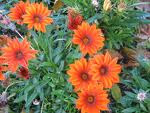The foxglove is a common woodland plant in Britain, and it grows in many countries all over the world, although there are different varieties of the foxglove. It is known by many names, such as:-Dead Man’s Bells, Fairy Caps, Gloves of Our Lady, Bloody Fingers and Virgin’s Glove. Honey bees are very attracted to these flowers, and they are responsible for the development of life saving medication. However they are highly poisonous and have been mistaken for comfrey leaves. Foxglove leaves are distinguished by the veins which run down the leaf. The upper leaves on the plant are more poisonous than the lower ones, and if you have children, you should not grow foxgloves in the garden.
 No one really knows where the name foxglove comes from, but the name is similar in Norwegian, Revbielde meaning fox bell. One northern legend says that bad fairies gave the flowers to a fox to slip onto his paws so that he could be more silent and stealthy while prowling around roosts of birds and chicken coops. It is also said that the older name for foxglove was Folk’s Glove, meaning the little folk or fairies. The foxglove grows in woods and hollows where, it was supposed, fairies liked to frequent. It is a member of the Scrophulariaceae or figwort family of plants and so is related to mullein and toadflax among others.
No one really knows where the name foxglove comes from, but the name is similar in Norwegian, Revbielde meaning fox bell. One northern legend says that bad fairies gave the flowers to a fox to slip onto his paws so that he could be more silent and stealthy while prowling around roosts of birds and chicken coops. It is also said that the older name for foxglove was Folk’s Glove, meaning the little folk or fairies. The foxglove grows in woods and hollows where, it was supposed, fairies liked to frequent. It is a member of the Scrophulariaceae or figwort family of plants and so is related to mullein and toadflax among others. The spotted parts of the flower were thought to be where elves had placed their fingers, but in Ireland where the plant is known as Dead Man’s Thimbles, they are supposed to be a warning of the poisonous juices contained in the plant.
 The Latin name, Digitalis means “a finger’s breadth” and a digitabulum was Latin for thimble. Purpurea means purple, as you might have imagined. The plant was not given a Latin name until 1542 when it was named by the German herbalist, Leonard Fuchs who gave his name to the fuchsia.
The Latin name, Digitalis means “a finger’s breadth” and a digitabulum was Latin for thimble. Purpurea means purple, as you might have imagined. The plant was not given a Latin name until 1542 when it was named by the German herbalist, Leonard Fuchs who gave his name to the fuchsia. Shakespeare doesn’t mention the foxglove, but Gerard writes without much evidence one would think, that it was good for people “who have fallen from high places.” Dodoens writing in 1554 says that boiled in wine the leaves could be used as an expectorant, one of the uses that were employed in other times which would be considered highly dangerous today. It was used in Italy to heal wounds, done by bruising a leaf and placing it firmly over a fresh wound. It was used by physicians in Wales in the 13th century and later used in North Wales to darken engraved lines on stone floors to give a mosaic pattern, which was fashionable at one time.
It was Doctor William Withering, an 18th Century English country doctor who was instrumental in discovering the effects of digitoxin and digiton on the heart. He was interested in the concoctions of a herbalist and went on to investigate the uses for the foxglove.
 Digitalis is used for heart treatments as it regulates irregular pulse rates, although it takes 12 hours to have benefits, so other medication is used to see the patient through those critical 12 hours. The cardiac glycosides it contains stimulate urine production and this lowers the volume of blood and lessens the load on the heart. It was used in ancient India to treat patients with swollen legs caused excess water, which are symptoms of a weak heart. It is a powerful diuretic. It is also used by injection as an antidote for aconite poisoning.
Digitalis is used for heart treatments as it regulates irregular pulse rates, although it takes 12 hours to have benefits, so other medication is used to see the patient through those critical 12 hours. The cardiac glycosides it contains stimulate urine production and this lowers the volume of blood and lessens the load on the heart. It was used in ancient India to treat patients with swollen legs caused excess water, which are symptoms of a weak heart. It is a powerful diuretic. It is also used by injection as an antidote for aconite poisoning. Please treat foxgloves with care, they are poisonous and dangerous and probably don’t taste good.




















